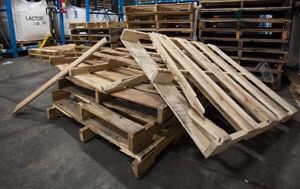The average lifespan of wooden pallets is approximately 3-5 years, which certainly isn’t a short lifespan for a product that is constantly carrying heavy loads across the country. However, we know that it’s every supply chain manager’s goal to increase the lifespan of their pallets without sacrificing the safety of products and the employees that handle the pallets on a day-to-day basis. Because, of course, a longer pallet lifespan means less money spent on pallets.
So, in today’s post, we’ll share tips on how you can extend the life of your pallets and reuse them time and time again for a more cost-effective pallet solution.
1. Train Employees on Proper Pallet Handling
Most pallet damage is due to human error and the constant need to work quickly. By training employees how to properly load and manage pallets, you can prevent pallet damage which will help to increase wood pallets’ lifespan. Below are some easy to remember tips to share with your workforce.
Pallet Handling Tips
- Avoid pushing and dragging pallets across the floor. Pallets are designed to be picked up when transported.
- Align forklift slowly, carefully to avoid damaging the pallet’s lead board.
- Insert pallet jack and forklift tines fully before lifting.
- Do not drop pallets.
- Do not step on pallets. If you must step on pallets, only step where the board is reinforced by a block or stringer.
- Never stack pallets more than about four to six feet high. This makes them easier to handle and can prevent them from toppling over and causing damage.
- Stack pallets uniformly. A straighter stack is less likely to fall over.
- Don’t stand pallets on their side. They can easily fall over, causing damage to the pallet.
- Check load capacity before transporting pallets.
- Pallets are often loaded beyond their weight capacity which can cause them to warp or crack, weakening the pallet’s overall strength and cutting down their lifespan. To reduce the likelihood of damage, make sure employees are informed of pallets’ load capacity.
2. Consistently Repair Wooden Pallets
It’s important to emphasize that you should never continue to use a damaged pallet, as it causes safety hazards. But, before throwing out damaged pallets, remember that you can repair them at a much cheaper rate than buying new pallets. For best results, make sure to regularly inspect your pallets and make it a priority to repair them at the first sign of damage to keep them going as long as possible.
You don’t have to dispose of slightly damaged pallets. Instead, make use of what is still good and repair the rest. You can replace broken boards and reinforce warped or broken stringers with new stringers to create “almost new” pallets that can keep going for years to come.
3. Consider Using Treated Pallets.
Although treated pallets may bear an additional cost, it could end up saving you money in the end. Untreated pallets are more easily weakened by moisture, inclement weather, and bugs, which will limit their overall lifespan. In fact, research conducted at Virginia Tech revealed that using air-dried material instead of green lumber delivers a 43 percent improvement in durability.
4. Use a Pallet Recovery Program
A pallet recovery, repair, and return program is a closed-loop system that allows you to cut costs and extend the life of your pallets through consistent pallet repair.
At First Alliance Management Logistics (FALM), our pallet recovery system enables you to reuse the same pallet three to four times per year for up to an average of eight years – that’s about twice the average wood pallet lifespan.
5. Choose the Right Pallet Design
When sourcing your pallets, make sure they are designed for the product they’re going to carry. Oddly-shaped items, heavy items, etc. should be transported on pallets that have been designed with the product in mind. While standard pallet sizes may be appropriate, discuss whether or not customized pallets are a better option with your pallet provider. 
To ensure your pallets are durable enough for their load, the right pallet provider will use the Pallet Design System (PDS) that can determine the pallet design that best suits your products. According to the NWPCA’s website, “The PDS structural analysis and safe load estimates reduce concerns over human health and safety, and reduce or eliminate product damage which can result from inadequate pallet strength, stiffness, or durability.”
6. Prioritize Quality
While it can be tempting to pay lower upfront costs when purchasing pallets, this industry is certainly one where the phrase “You get what you pay for,” rings true. Well-made pallets will always outlast poorly-made pallets, which are more apt to distort under weight.
So, to get the most value, choose a quality pallet from the start and it will reduce the constant need to replace cheap pallets with a short lifetime.
Get the Most Out of Your Pallets
In the end, the lifespan of your wooden pallets will depend on how well they were taken care of and if they were consistently repaired at the first sight of damage. If you want to create a more economical pallet solution, use these tips and start getting the most out of your pallets. If you’re looking for custom or used wooden pallets, make First Alliance Logistics Management your pallet vendor of choice.


